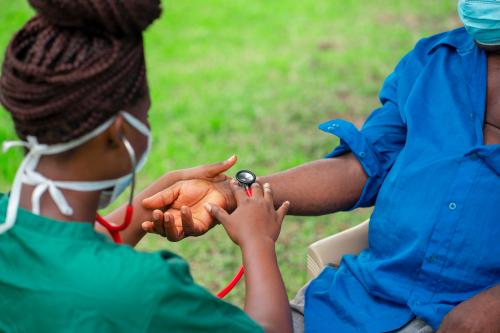Recent decades have seen considerable progress in fighting illnesses around the world. More than 18.2 million people are now receiving life-saving AIDS treatment. The malaria death rate among children under age five is down 69 percent since 2000. Efforts to diagnose and treat tuberculosis, a disease that has plagued humanity for centuries, have saved millions of lives.
Investments in research and development (R&D) by the public, private, and non-profit sectors have been crucial to the health gains made to date. Public sector investment clearly remains important, but maximizing the impact of global health R&D will require a sustained effort on the part of the private sector as well. For that reason, the Brookings Private Sector Global Health R&D Project is dedicated to finding ways to strengthen private investment in global health R&D.
In this report—the second published by the Project—authors Darrell West, John Villasenor, and Jake Schneider examine current private sector spending by pharmaceutical firms, venture capital funds, and impact investors in global health R&D. They analyze three types of R&D spending and, using data from a number of sources, calculate how much the private sector currently invests in each:
- Overall R&D focused on drugs, vaccines, and therapeutics in the developed and developing world: The authors calculate that there is an annual total of at least $159.9 billion spent on overall health R&D. This includes $156.7 billion from pharmaceutical companies and at least $3.2 billion from venture capital.
- Global health R&D that emphasizes medical treatments in the developing world: An estimated annual total of $5.9 billion is spent on global health R&D focused on the developing world, with $5.6 billion coming from pharmaceutical firms and $225.8 million from venture capital companies.
- Neglected disease R&D, which focuses on drugs, vaccines, and therapeutics for 35 specific illnesses that primarily impact populations in very poor nations: This category attracts the least private R&D money with a total of $471 million from pharmaceutical funders and $40 million from impact investors.
The authors also find that in recent years, there have been substantial increases in R&D spending by Chinese, Indian, and other non-Western pharmaceutical companies. While still trailing Western firms by a considerable amount, the Chinese pharmaceutical industry raised its overall health spending from $163 million in 2000 to $7.2 billion in 2016. Indian companies went from $480 million in 2008 to $1.9 billion in 2016.
“Looking to the future,” the authors write, “there will likely be a slowdown in public health investment.” Recognizing that private spending on global health R&D will become ever more critical, West, Villasenor, and Schneider close by making several recommendations for increasing such investment. Their recommendations include: creating viable markets; responding to the desire for systematic data; expediting regulatory reviews of new drugs and vaccines; encouraging R&D tax incentives; encouraging venture fund investments through redesigned priority review vouchers; implementing a World Health Organization vaccine platform; and pursuing investment opportunities in China and India—where more than 35 percent of the global population resides.
Download the full paper here. Comments and feedback can be sent to [email protected].





